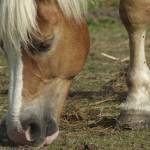Drylots for Horses

Small paddocks that contain little or no vegetation are called drylots. As understanding of laminitis and metabolic issues increases among horse owners, drylots are becoming more commonplace on farms.
Drylots convey various benefits, but the most prominent is probably controlled forage intake in a more natural environment. Research has shown that horses are healthiest when allowed to move about freely. The incidence of colic, as an example, decreases as horses are permitted to spend more time roaming and foraging. Though drylots are not necessarily large, multi-acre enclosures, they offer more room to roam than an average stall. The quality and quantity of forage offered during turnout in a drylot can be managed, and forage can be placed in different areas of the drylot to encourage movement.
Special attention should be paid to weed control in a drylot. Horses have an eclectic palate with a natural tendency to nibble on weeds and other vegetation, particularly if the allotment of hay or other forage is strictly monitored. Under normal grazing conditions, horses might bypass these weeds, but when there is nothing else more appealing to eat, they may eat them, and some might be poisonous. For this reason, some people allow no vegetation whatsoever to grow in the drylot.
Providing companionship and forage of some type (depending on the horse’s nutritional requirement) will discourage wood-chewing and cribbing. Horses have a physiological need or craving for fiber, and without sufficient fiber, they will often seek out fence posts or boards on which to seek satisfaction for this craving.
So, when is a drylot not really a drylot? If the drylot contains sufficient plant growth to require regular mowing of the grass, and not just periodic trimming of weeds, it’s probably not a drylot. If an easy keeper can maintain its weight in the area with no supplementary forage, it’s probably not a drylot. If you’re regularly seeding and fertilizing a drylot as you would other grazing areas, it’s definitely not a drylot.
While this may seem an easy-to-understand concept, some horse owners believe a drylot is simply an inferior area on an otherwise lush farm. At times, these areas are more like “lushlots” than drylots and are potentially dangerous for horses with metabolic issues. Horses will likely keep the grass short in drylots due to restricted space, but the new growth on short grass has higher sugar content than mature grass.
Drylots can quickly become muddy. Shod horses may lose shoes more frequently in muddy areas, and the mire often provides a breeding environment for pests such as flies and mosquitoes and for disease-causing pathogens. To avoid mud and to provide horses with year-round firm footing, some thought should be given to constructing a high-traffic pad from stones, rocks, aggregates, or other materials after appropriate grading and preparation of land.
Drylots are an effective solution to the ever-growing problem of obesity in the modern horse population, and can be a life-saving management tool for metabolic horses especially sensitive to pasture grasses.








